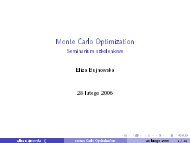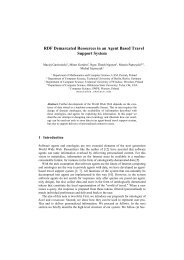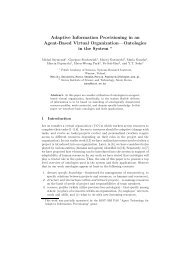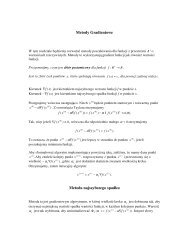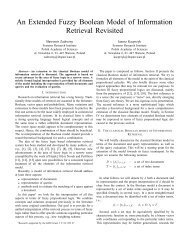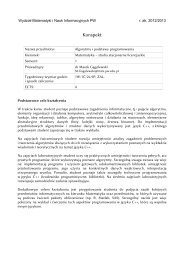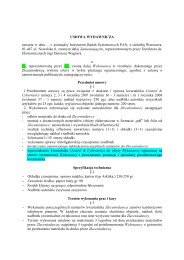<strong>Knowledge</strong> <strong>M<strong>an</strong>agement</strong> <strong>in</strong> <strong>an</strong> E-<strong>commerce</strong> <strong>System</strong> 63.4 <strong>Knowledge</strong> acquisition techniques <strong>an</strong>d methods<strong>Knowledge</strong> acquisition from the data stored <strong>in</strong> the system applies primarily to the data collected from/about the customers<strong>an</strong>d the environment (as seen above, knowledge acquisition from experts is achieved <strong>in</strong> a different, more direct, way).Techniques for knowledge acquisition from electronic data/<strong>in</strong>formation sources has been studied for some time <strong>an</strong>d somesignific<strong>an</strong>t adv<strong>an</strong>ces have been already made. The general name for the processes that extract knowledge from electronicsources is knowledge discovery from databases (see also [7, 13, 15, 17, 27]).As it was stressed <strong>in</strong> the Introduction, knowledge m<strong>an</strong>agement is a cont<strong>in</strong>uous process of knowledge acquisition,tr<strong>an</strong>sfer <strong>an</strong>d application, where by apply<strong>in</strong>g knowledge new knowledge c<strong>an</strong> be acquired aga<strong>in</strong>. Therefore, it is thelearn<strong>in</strong>g process that results from <strong>in</strong>teractions between the system <strong>an</strong>d the three data sources described above that is oneof the more import<strong>an</strong>t sources of knowledge <strong>in</strong> the system. This process mimics that of real org<strong>an</strong>izations <strong>in</strong> the worldeconomy, <strong>in</strong> which knowledge is acquired, not through a s<strong>in</strong>gle act, but through a cont<strong>in</strong>uous process of improvement onknowledge ga<strong>in</strong>ed thus far. In order to meet the requirements of a dynamically <strong>an</strong>d often unpredictably ch<strong>an</strong>g<strong>in</strong>g world,knowledge acquisition must <strong>in</strong>volve both knowledge adaptation <strong>an</strong>d knowledge evolution.<strong>Knowledge</strong> adaptation <strong>in</strong>volves addition of new knowledge to that already exist<strong>in</strong>g, the creation of entirely newknowledge, the deprecation of irrelev<strong>an</strong>t knowledge <strong>an</strong>d the deletion of dead knowledge. <strong>Knowledge</strong> acquired from theknowledge may be relatively const<strong>an</strong>t or especially liquid, because it often concerns trends <strong>in</strong> hum<strong>an</strong> behavior, whichr<strong>an</strong>ge from basic social tendencies to current fads. All of this knowledge must be correlated <strong>an</strong>d evaluated accord<strong>in</strong>g tohow much it adds to the system’s exist<strong>in</strong>g body of knowledge as well as other factors such as time dependency. Similarly,knowledge, which has ceased to be useful to the system, especially because it has become outdated, must be deprecated<strong>an</strong>d removed from the system. This <strong>in</strong>cludes time-dependent events as well as models <strong>an</strong>d techniques the system employs<strong>in</strong> bus<strong>in</strong>ess that have been superseded by better ones. In e-<strong>commerce</strong> systems adaptation is not a homogenous process.There are at least two types of adaptation: on-l<strong>in</strong>e <strong>an</strong>d offl<strong>in</strong>e. The first occurs while the customer is onl<strong>in</strong>e <strong>an</strong>d thesystem is assist<strong>in</strong>g him, while the latter is a complex process that <strong>in</strong>tegrates <strong>an</strong>d <strong>an</strong>alyzes all of the <strong>in</strong>formation collectedby the system that may <strong>in</strong>fluence system knowledge. In this case the process of knowledge adaptation of <strong>in</strong>separable fromthat of knowledge evolution. This refers to the process of apply<strong>in</strong>g trend <strong>an</strong>alysis <strong>in</strong> <strong>an</strong> attempt to <strong>an</strong>swer the questions:what is ch<strong>an</strong>g<strong>in</strong>g? how frequent does a ch<strong>an</strong>ge take place? This time dependent <strong>an</strong>alysis gives us <strong>in</strong>sight <strong>in</strong>to knowledgeevolution <strong>in</strong> the environment <strong>an</strong>d <strong>in</strong> the e-<strong>commerce</strong> system. To be able to conduct such <strong>an</strong>alysis it is necessary to collecthistorical data about the e-<strong>commerce</strong> system.4. HIGHER-LEVEL-KNOWLEDGE: GENERAL CONSIDERATIONSAt this po<strong>in</strong>t we assume that there exists a layer of low-level knowledge acquired from the sources described above <strong>an</strong>dresid<strong>in</strong>g <strong>in</strong> the knowledge base, which is divided <strong>in</strong>to source areas (user behavior, hum<strong>an</strong> experts, news, etc.). While thislow-level knowledge may be <strong>in</strong>terest<strong>in</strong>g <strong>in</strong> itself, it is not especially useful for e-<strong>commerce</strong>. In order for the system totake adv<strong>an</strong>tage of knowledge from disparate sources it must group these knowledge build<strong>in</strong>g blocks <strong>in</strong>to a functionalframework. In fact, there are m<strong>an</strong>y such frameworks exist<strong>in</strong>g <strong>in</strong> the system at the same time, each a different view on asubset of the system’s knowledge. The existence of a variety of knowledge frameworks closely parallels knowledge roles<strong>in</strong> hum<strong>an</strong> org<strong>an</strong>ization, <strong>in</strong> which no one knowledge bearer is responsible for all of the functions of the org<strong>an</strong>ization, <strong>an</strong>dthus each only requires a subset of the org<strong>an</strong>ization’s knowledge. In fact, beyond the small scale it is impossible for <strong>an</strong>yentity to possess more th<strong>an</strong> a subset of the total knowledge. It is the union of these subsets, embodied <strong>in</strong> the form of“components” (hum<strong>an</strong>, electronic or other knowledge-bear<strong>in</strong>g mediums) possess<strong>in</strong>g knowledge that def<strong>in</strong>es theorg<strong>an</strong>ization. Of course there is <strong>an</strong> <strong>in</strong>herent overlap between knowledge blocks used by various components. Differentuses of the same knowledge lead to the further ref<strong>in</strong>ement of that knowledge, as general knowledge splits <strong>in</strong>to morespecialized parts. This pattern of generalization to specialization creates a highly relev<strong>an</strong>t web-like structure of low-levelknowledge with<strong>in</strong> the system. More precisely, there may be m<strong>an</strong>y such structures built out of low-level knowledge, e.g.various departments require different knowledge to fulfill their goals. Observe also, that knowledge that is very import<strong>an</strong>tto one group may be less import<strong>an</strong>t to the other; this does not ch<strong>an</strong>ge the knowledge <strong>in</strong> itself, but only the role it plays <strong>in</strong>the knowledge framework build to support actions of a given group.International Conference on Electronic Commerce Research (ICECR-5)
<strong>Knowledge</strong> <strong>M<strong>an</strong>agement</strong> <strong>in</strong> <strong>an</strong> E-<strong>commerce</strong> <strong>System</strong> 7As the different people / departments <strong>in</strong> a traditional <strong>commerce</strong> org<strong>an</strong>ization have different roles <strong>an</strong>d employ theorg<strong>an</strong>ization’s knowledge <strong>in</strong> different fashions / from different perspectives, so too does the e-<strong>commerce</strong> system conta<strong>in</strong> avariety of components, each of which requires access to a subset of the system’s knowledge <strong>an</strong>d has a “perspective” onthat subset. For example, the components driv<strong>in</strong>g the user <strong>in</strong>terface to the system are primarily concerned with knowledgethat affects how users <strong>in</strong>teract with the system. This <strong>in</strong>cludes knowledge of hum<strong>an</strong> sensory psychology <strong>an</strong>d <strong>in</strong>terface“usability” as well as the limits of the technologies used for display<strong>in</strong>g the <strong>in</strong>terface (such as the web). All of thisknowledge is low-level, acquired from hum<strong>an</strong> experts <strong>an</strong>d system learn<strong>in</strong>g as described above. It is the perspective of theuser <strong>in</strong>terface components, which groups the otherwise disparate low-level knowledge <strong>in</strong>to a framework useful fordriv<strong>in</strong>g the user <strong>in</strong>terface.This perspective-framework is referred to as <strong>an</strong> ontology. While this term has a traditional philosophical me<strong>an</strong><strong>in</strong>g ofthe “study of be<strong>in</strong>g”, <strong>in</strong> the world of the Internet it refers to a formalized medium of represent<strong>in</strong>g knowledge. The basicstructure employed here has its orig<strong>in</strong>s <strong>in</strong> the frame-based representation described by Marv<strong>in</strong> M<strong>in</strong>sky [18]. In essence, aframe is a subset of knowledge, which is used by <strong>an</strong> “actor” to conceptualize the situation. A frame may conta<strong>in</strong> subframes,which are other perspectives subsumed by the greater picture.Figure 1. Perspectives on low-level knowledge <strong>in</strong> the systemThis idea extends naturally <strong>in</strong>to the doma<strong>in</strong> of e-<strong>commerce</strong>, where ontology is a way of structur<strong>in</strong>g the electronicreality that <strong>an</strong> e-<strong>commerce</strong> system has to deal with. S<strong>in</strong>ce various functional units have to achieve <strong>in</strong>dividual goals, eachwill need its own ontology. As <strong>an</strong> example we may consider the user <strong>in</strong>terface components that require ontology of<strong>in</strong>terface-related knowledge. Each component with<strong>in</strong> this set of user <strong>in</strong>terface components may have a smaller ontologythat refers to the specific doma<strong>in</strong> of action of that component. Thus the component ontologies are subsumed by the largerontology needed by user <strong>in</strong>terfaces, which ontology is subsumed by that pert<strong>in</strong>ent to e-<strong>commerce</strong> customer support,which <strong>in</strong> turn is encompassed by the ontology for the system itself, which refers to all knowledge available to the system<strong>an</strong>d how it is <strong>in</strong>terrelated to each other. Realistically, such a total ontology may not exist, even for such a limited doma<strong>in</strong>as e-<strong>commerce</strong> [8]. Practical considerations aside, m<strong>an</strong>y <strong>in</strong> the field of ontologies <strong>an</strong>d sem<strong>an</strong>tic process<strong>in</strong>g are currentlyattempt<strong>in</strong>g to def<strong>in</strong>e even larger ontologies, for describ<strong>in</strong>g the entirety of hum<strong>an</strong>-recognized reality [4]. In Figure 1 weillustrate the situation where two low level ontologies are utilized by two higher-level ontologies. Nodes <strong>in</strong> the ontologyInternational Conference on Electronic Commerce Research (ICECR-5)



